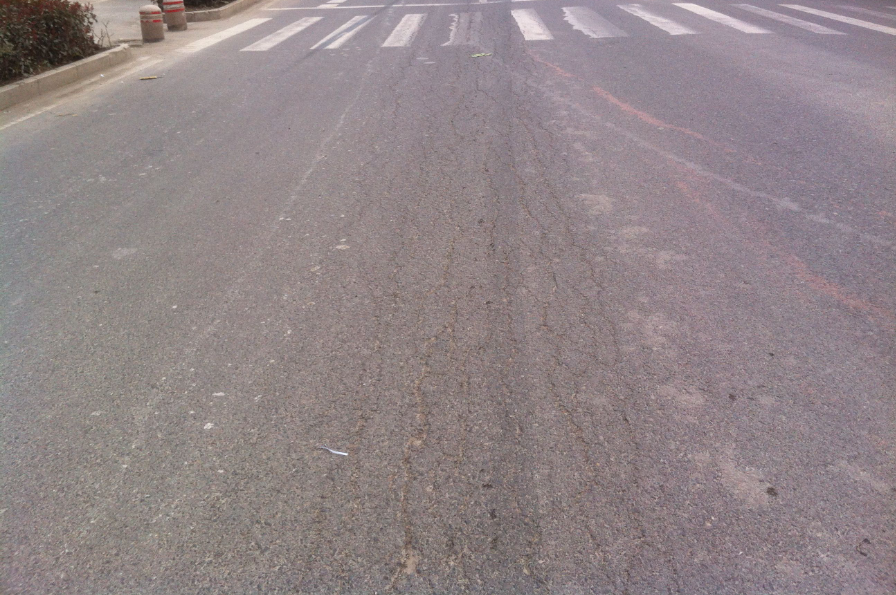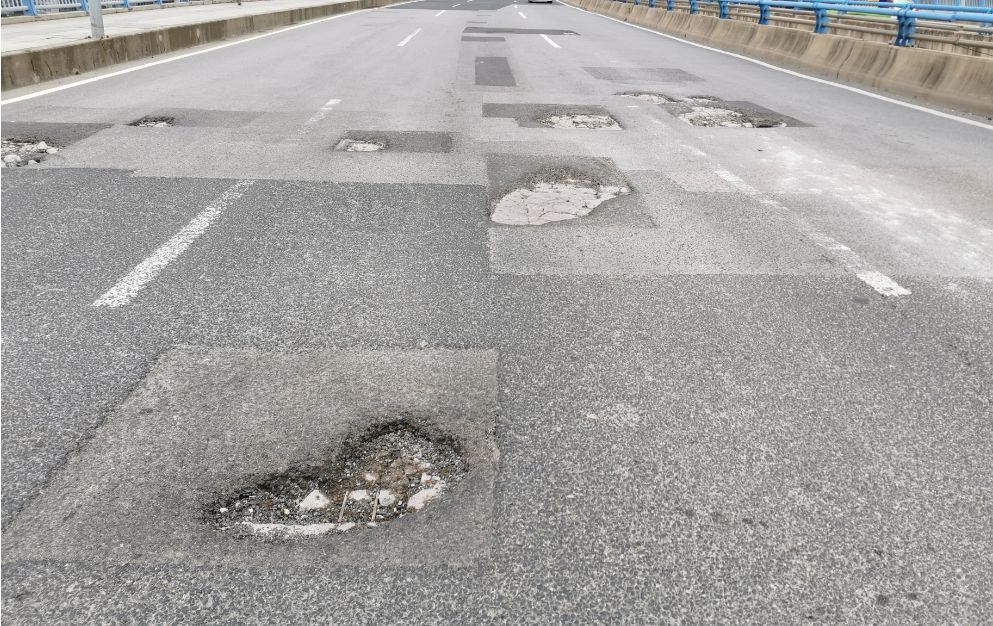

Asphalt pavement is widely used in highway construction because of its strong adaptability to geological conditions, comfortable driving and convenient maintenance. However, asphalt pavement is prone to various diseases for various reasons. If it is not treated in time, it will affect the service performance of the road. Combined with the author's practical experience, this paper discusses the common diseases and maintenance measures of asphalt pavement.
1. Common diseases of Asphalt Pavement
The early damage phenomena of asphalt pavement include rutting, cracks, pits and so on. These diseases are very common and serious, and are one of the common quality problems of highway engineering.
1.1 rutting
Rutting refers to the longitudinal banded groove on the road along the driving wheel track, with a depth of more than 1.5cm. Rutting is a banded groove formed by the accumulation of permanent deformation of the pavement under the repeated action of driving load. Rutting reduces the flatness of the road surface. When the rutting reaches a certain depth, due to the accumulated water in the rutting groove, it is very easy to cause traffic accidents due to vehicle floating and sliding. Rutting is mainly caused by unreasonable design and serious overloading of vehicles.
1.2 cracks
There are three main forms of cracks: longitudinal cracks, transverse cracks and mesh cracks. Cracks in asphalt pavement will lead to water seepage and endanger the surface course and base course.
1.3 pit
Pit is a common early disease of asphalt pavement, which means that the pavement is damaged into a pit with a depth of more than 2cm and an area of 0.04m ² above. The formation of pits is mainly due to the penetration of vehicle repair or motor vehicle oil into the pavement, which makes the asphalt mixture loose due to pollution, and gradually forms pits after rolling by driving.
1.4 peeling
Asphalt pavement peeling refers to the peeling off of the pavement layer by layer, with an area of 0.1M ² above. The peeling of asphalt pavement is mainly due to water damage.
1.5 loose
The looseness of asphalt pavement refers to the loss of cohesive force of pavement binder and loose aggregate, with an area of 0.1M ² above.

2. Maintenance measures for common diseases of Asphalt Pavement
For the early diseases of asphalt pavement, we should do a good job in maintenance in time, so as to minimize the impact of diseases on driving safety of asphalt pavement.
2.1 rutting maintenance
The maintenance and treatment methods of asphalt road rut mainly include the following:
2.1.1 if the lane surface is rutted due to the moving surface of vehicles. The rutted surface shall be removed by cutting or milling, and then the asphalt surface shall be repaved. Then use asphalt mastic macadam mixture (SMA) or SBS modified asphalt single mixture or polyethylene modified asphalt mixture to repair rutting.
2.1.2 if the transverse wave rutting formed by the transverse pushing of the pavement has been stabilized, the protruding part can be cut off, the trough part can be sprayed or painted with bonded asphalt, filled with asphalt mixture, leveled and compacted.
2.1.3 in case of rutting caused by local settlement of the base due to insufficient strength and poor water stability of the base, the base shall be treated first. Completely excavate the surface course and base course.
2.2 crack repair
After the asphalt pavement cracks occur, if all or most of the minor cracks can be healed in the high temperature season, they can not be treated. If it is certain that it is a slight crack that cannot be healed in the high temperature season, it shall be repaired in time to control the further expansion of the crack, prevent the early damage of the pavement and improve the service efficiency of the highway. Similarly, in the maintenance of asphalt pavement cracks, the process operation and specification requirements should be strictly enforced.
2.2.1 oil filling repair method. In winter festival, clean the vertical and horizontal cracks, heat the joint wall to viscous state with liquefied gas, spray asphalt or asphalt mortar (emulsified asphalt should be sprayed in low-temperature and wet seasons), spray it into the joint, and then evenly sprinkle a layer of 2 ~ 5mm dry clean stone chips or coarse sand for protection. Finally, roll the mineral aggregate with a light roller. If it is a small crack, it shall be widened with a disc milling cutter in advance, and then treated according to the above method, and a small amount of asphalt with low consistency shall be painted along the crack.
2.2.2 repair the cracked asphalt pavement. During construction, the old traces of cracks shall be chiseled off to form a V-shaped groove; Then use the air compressor to blow away the loose parts, dust and other sundries in and around the V-shaped groove, and then pour the evenly mixed repair material into the crack through the extrusion gun to make it full. After the repair material solidifies, the traffic can be opened for about a day. In addition, if serious cracks are caused by insufficient strength of soil foundation and base course or subgrade churning, the base course shall be treated first and then the surface shall be made again.
2.3 pit care
2.3.1 the base course of the pavement is intact, and the nursing method when only the surface course has pits. According to the principle of "round hole square repair", draw the pit repair contour line parallel or perpendicular to the center line of the road, carry out it according to rectangle or square, chisel the pit to the stable part, remove the dust and loose part of the groove bottom and groove wall with an air compressor, and then put it at the clean groove bottom; Spray a thin layer of bonded asphalt on the tank wall, and then fill and pave the prepared asphalt mixture. Then, the hand roller shall be used for rolling to ensure that the rolling strength directly acts on the paved asphalt mixture. With this method, cracks and other phenomena will not occur.
2.3.2 hot repair method. The hot repair and maintenance vehicle is used to heat the pavement at the pit and groove with the heating plate, loosen the heated and softened pavement, spray emulsified asphalt, add new asphalt mixture, mix and pave, and compact with the roller.
2.3.3 if pits are formed due to the damage of the base due to insufficient local strength of the base, the surface course and base course shall be completely excavated.

2.4 maintenance of peeling
2.4.1 for peeling caused by poor bonding between the asphalt surface course and the upper seal course or poor initial maintenance, the fallen and loosened parts shall be removed, and then the upper seal course shall be made again. The asphalt dosage and mineral aggregate particle size specification of the seal course shall depend on the thickness of the seal course.
2.4.2 if peeling occurs between layers of asphalt surface, the falling off and loose parts shall be removed, the bonded asphalt shall be painted on the lower asphalt surface, and the asphalt layer shall be made again.
2.4.3 for peeling caused by poor bonding between the surface course and the base course, the peeling and loose surface course shall be removed first, and the causes of poor bonding shall be analyzed.
2.5 loose maintenance
2.5.1 if there is slight pitting due to the loss of caulking material, when the asphalt surface is not poor in oil, appropriate caulking material can be sprinkled in the high-temperature season and swept evenly with a broom to fill the caulking material into the gap of stone.
2.5.2 spray asphalt with high consistency on a large area of pitted surface, and sprinkle caulking material with appropriate particle size. The caulking material in the middle of the pitted surface shall be slightly thicker, the surrounding interface with the original pavement shall be slightly thinner, the shaping shall be neat, and rolled into shape.
2.5.3 the pavement is loose due to poor adhesion between asphalt and acid stone. The surface course shall be rebuilt after all loose parts are excavated. Acid stone shall not be used for the mineral materials of the surface course.
In short, during the use of asphalt pavement, it is inevitable that there will be ruts, cracks, looseness, pits, peeling and other damage diseases. If it cannot be repaired in time and effectively, it will further aggravate and spread the diseases, accelerate the damage of asphalt pavement and affect the safety performance of the road. To sum up, we should fully understand the different types of damage diseases in the use process, carefully investigate and study, take effective technical measures and timely repair, so as to maintain the integrity of the pavement and improve the service performance of the road.
Address : No. 1001 Longxiang Industrial Park, Weidu District,XuChang,HeNan, China
Tel : 4000-676-878
Code : 461000
Email : sales@sinoroader.com
Wechat : Sinosun
WhatsApp :+86 18224529750



